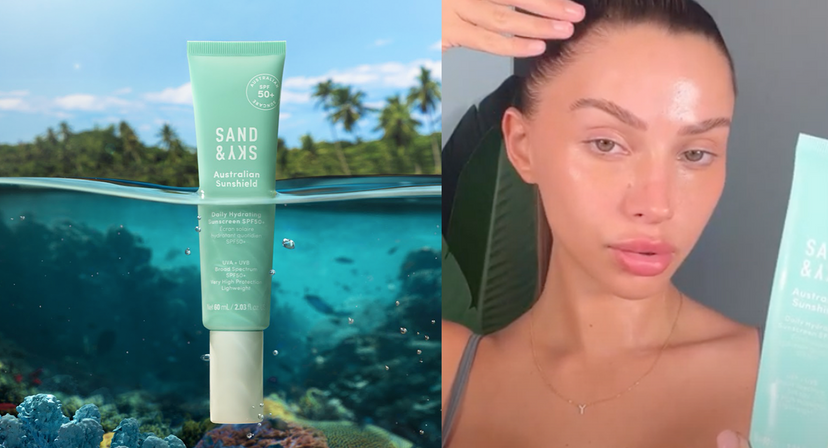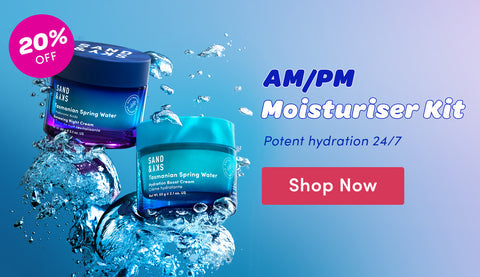From the difference between UVA and UVB to why Aussie sunscreens are considered the cream of the crop, we tackle all your burning questions. Read on for the answers you’ve been searching for, plus the sunscreen application rules to follow for maximum protection.
- What's the difference between SPF30 and SPF50+ protection?
The first thing most of us consider when browsing the sun care aisle, the Sun Protection Factor or SPF of a sunscreen measures how well it protects the skin against burning UVB rays. An SPF30 sunscreen blocks 97% of UVB rays from reaching your skin, while SPF50 blocks 98%.
But do you know what the number listed refers to? Do SPF15, 30, and 50 sunscreens protect you for 15, 30 and 50 mins, respectively?
This is a common misconception, but SPF does not measure protection time in minutes. Instead, it indicates how much longer it would take your skin to redden while wearing sunscreen than without it. So, if you usually start to burn in 5 minutes, a properly applied SPF30 sunscreen should theoretically protect you for 150 minutes – or 30 times longer. And for an SPF50 sunscreen, this would be 250 minutes.
Got a plus at the end of your number? This simply means ‘more than’. So, an SPF50+ product like our Daily Hydrating Sunscreen has an SPF of more than 50.
The difference between our Tinted Glow Primer SPF30 & the Daily Hydrating Sunscreen SPF50+? We've got you covered!

- What does broad spectrum protection mean?
A broad-spectrum sunscreen is simply one that filters out UVA rays as well as UVB. Why is this important? Because, while we’ve long known UVB brings the burn, it’s only in the past few decades we’ve woken up to the fact UVA also contributes to the risk of skin cancer.
Another not-so-fun-fact about UVA radiation… Making up 95% of the invisible ultraviolet rays reaching the earth’s surface2, longer wavelength UVA rays penetrate more deeply into the skin and are the key cause of photo-ageing (sun-induced ageing). Unlike UVB rays which fluctuate throughout the year, UVA radiation is present at consistent levels – and even able to cut through glass.
So, if you want to keep premature wrinkles, sagging and sunspots at bay, make broad-spectrum sun protection part of your daily routine. With an SPF of 50+ and a lightweight, fast-absorbing formula, our Daily Hydrating Sunscreen delivers very high level UVA and UVB protection and hydration for all skin types – all year round.

- Why are Australian Sunscreens the best?
Australian sunscreens are regulated by the Therapeutic Goods Administration (TGA), and we have the strictest requirements in most categories. We use the same definition of broad spectrum as the EU, which is stricter than in the US. And our water resistance definition is stricter than the EU’s (and the same as America’s).
We're also ahead of the pack when it comes to UVA protection, with the TGA approving a wider, newer range of filters that are better at protecting against those pesky, prematurely ageing rays.
- How much sunscreen should I use?
Another crucial thing to keep in mind is not to skimp when applying – and reapplying – sunscreen. Most of us apply too little and this can significantly reduce the SPF of the product you’re applying. That SPF50 (you think) you’re wearing? If you don’t apply it liberally, it might only be delivering an SPF of 30 – or lower.
So how much sunscreen should you apply? According to the Cancer Council, sunscreen should be applied to clean, dry skin 20 minutes before sun exposure. For most adults, one full teaspoon (or 5mL) is required for each limb, the back of your body, the front of your body, and the face, neck and ears (combined). That’s seven teaspoons all up – and a lot more than most of us are using.
Once your sunscreen's on, you also need to remember to reapply it every two hours, regardless of the SPF. Swimming, exercising or getting hot and sweaty? You'll need to reapply your sunscreen more often to ensure you stay protected.
- What’s the difference between Chemical and Physical Sunscreen?
Chemical UV filters, on the other hand, absorb UV radiation and convert it into heat. There are nearly 30 approved for use in Australia, and they all have different abilities to absorb UVB and/or UVA rays. Some of the commonly used filters include oxybenzone, homosalate, octisalate, octocrylene and avobenzone – and many products use a combination to achieve the highest level of protection.
While physical sunscreens have come a long way since the ultra-heavy white formulas of your youth, chemical formula are generally lighter, sheerer and more comfortable to wear. However, it’s important to note that these sunscreens need to be applied 20 minutes before sun exposure to be effective.
You may have heard that mineral sunscreens are more suitable for sensitive skin. However, more and more, new chemical sunscreens, like ours, are being specifically formulated with sensitive skin-safe filters. Our Daily Hydrating Sunscreen SPF50+ is also free from all (potentially irritating) fragrances and contains aloe vera to soothe – as well as hydrating hyaluronic acid and antioxidant-charged Kakadu Plum.
Want more info on our all-new Aussie sunscreen? Check out this article, which includes everything you need to know!


